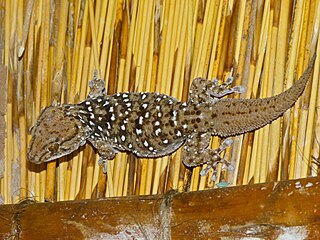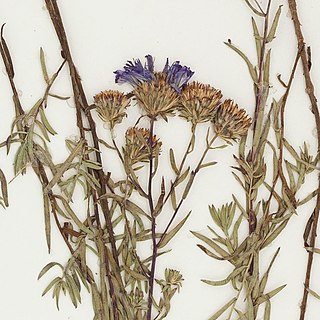
The torrent duck is a member of the duck, goose and swan family Anatidae. It is the only member of the genus Merganetta. It is placed in the shelduck subfamily Tadorninae after the "perching duck" assemblage to which it was formerly assigned was dissolved because it turned out to be paraphyletic.

Dallasaurus is a basal mosasauroid from the Upper Cretaceous of North America. Along with Russellosaurus, Dallasaurus is one of the two oldest mosasauroid taxa currently known from North America. It is also one of the smallest known mosasaurines, measuring approximately 1 m (3.3 ft) in length.

Turner's eremomela is a species of bird formerly placed in the "Old World warbler" (Sylviidae) assemblage, but now placed in the family Cisticolidae.

The Highland splitfin is a species of splitfin endemic to Mexico where it is found in the Lerma River basin. This species grows to a length of 5 centimetres (2.0 in) TL. It is the only known member of its genus, although some authorities have Hubbina as a subgenus of Girardinichthys and add Girardinichthys ireneae to the subgenus, even treating this taxon as a synonym of G. ireneae. This species was described by Don Fernando de Buen y Lozano in 1940 with the type locality given as Cointzio, Michoacán. The name of the genus honours the American ichthyologist Carl Leavitt Hubbs (1894-1979) while the specific name honours Clarence Lester Turner (1890-1969), thus honouring two ichthyologists who worked on a review of the Goodeidae in 1939.

Pittosporum turneri, commonly called Turner's kohuhu or the tent pole tree, is a species of plant in the Pittosporaceae family. It is endemic to New Zealand. P. turneri was first described by Donald Petrie in 1925. The species flowers between the months of October to December. P. turneri is threatened by possums. It is regarded as being Nationally Vulnerable.

Tillandsia turneri is a species of flowering plant in the family Bromeliaceae. This species is native to Venezuela, Colombia, Guyana, and northern Brazil.

Amoria turneri, common name Turner's volute, is a species of sea snail, a marine gastropod mollusk in the family Volutidae, the volutes.
Chrysoritis turneri, the Turner's opal, is a butterfly of the family Lycaenidae. It is found in South Africa.
Aparallactus turneri, or the Malindi centipede-eater, is a species of mildly venomous rear-fanged snake in the family Lamprophiidae. The species is endemic to Kenya.

Fallacosteus is an extinct monospecific genus of arthrodire placoderm from the Early Frasnian stage of the Late Devonian period, found at the Gogo Formation of Kimberley, Western Australia. As with almost all other camuropiscids, F. turneri had an elongated snout that may have enhanced its hydrodynamic streamlining.

Sybra is a genus of beetles in the family Cerambycidae, containing the following species:

Turner's thick-toed gecko is a species of lizard in the family Gekkonidae. The species is endemic to southern Africa.

Sybra umbratica is a species of beetle in the family Cerambycidae. It was described by Pascoe in 1865.
Sybra bioculata is a species of beetle in the family Cerambycidae. It was described by Pic in 1925. It contains four subspecies: Sybra bioculata bioculata, Sybra bioculata quadrinotata, Sybra bioculata sikkimana, and Sybra bioculata tigrina.

Sybra ordinata is a species of beetle in the family Cerambycidae. It was described by Henry Walter Bates in 1873.
Sybra pascoei is a species of beetle in the family Cerambycidae. It was described by Lameere in 1893.

Encephalartos turneri is a species of cycad that is native to Mozambique. The Encephalartos turneri was discovered by Ian Sutherland Turner in Nampula, Mozambique.

Austroepigomphus turneri, also known as Austroepigomphus (Xerogomphus) turneri, and up until recently Austrogomphus turneri, is a species of dragonfly of the family Gomphidae, commonly known as the flame-tipped hunter. It inhabits both rapid and slow streams and pools across northern Australia.

Symphyotrichum turneri is a species of flowering plant in the family Asteraceae native to Durango, Mexico.

Sierraceratops is a genus of chasmosaurine ceratopsian from the Late Cretaceous Hall Lake Formation of New Mexico, United States. The genus contains a single species, Sierraceratops turneri, known from a partial skeleton discovered in 1997.















